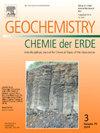Neotethyan Jurassic supra-subduction ophiolitic complex with Triassic subducted sole: Mineral chemistry, sole P–T estimates, and U/Pb geochronology of an intra-oceanic domain (Central Dinarides, Bosnia and Herzegovina)
IF 2.9
3区 地球科学
Q2 GEOCHEMISTRY & GEOPHYSICS
引用次数: 0
Abstract
The ophiolitic blocks in the Cretaceous mélanges of the Central Dinaridic Ozren and Borja–Mahnjača massifs revealed two different evolutionary periods of the Neotethys Ocean: (1) A pre-subduction Middle Triassic to Early Jurassic spreading, and (2) Late Early Jurassic (Toarcian) intra-oceanic subduction and the formation of late Early to Middle Jurassic supra-subduction ophiolitic complex. The goal of this paper is to report the rebuilding of the upper oceanic plate mid-ocean ridge (MOR) abyssal to supra-subduction zone (SSZ) ophiolites. This process is indicated by an increase of Cr# in spinel (Spl) from ~0.1 to 0.6, exceptionally to 0.75 in peridotite, the Mg# decrease in orthopyroxene1 (Opx1) from ~89–91.5 in abyssal to ~86–88 in SSZ types of peridotites, as well as with overall Al and Ti decrease in pyroxene1. However, refertilization was rarely detected in newly formed Cpx, Opx, and Spl (2, 3) generations. A relatively thin, amphibole (Amp)-rich gabbro-dolerite layer of this Jurassic Ozren–Borja–Mahnjača ophiolitic complex may have formed in a nascent fore-arc, slow-spreading ridge. Remnants of Middle Triassic oceanic crust was dated at 242 ± 1 Ma from a relic zircon population in a trondhjemite (remelted plagiogranitic) dyke of the sole eclogite by LA–ICP–MS U–Pb method, whereas its main zircon population of 176 ± 2 Ma constrains the metamorphic-anatectic recrystallization age of the dyke in eclogite. Another trondhjemitic dyke gave a magmatic crystallization zircon age of 216 ± 6 Ma with rare inherited Middle Triassic (240–230 Ma) zircon. The clinopyroxene (Cpx)–garnet (Grt)–rutile (Rt) eclogites indicate the intra-oceanic subduction of the Triassic oceanic crust to about 50 km, which was estimated from Perple_X modelling of 1.5–1.6 GPa and 860–870 °C. However, a sole skarn achieved 950 °C at 0.5 GPa. Metamorphic zircon of a sole eclogite yielded 173 ± 2 Ma (D1 subduction event at ~180–175 Ma). Partial melting of the subducted slab and the mantle wedge initiated the transition of MOR to SSZ type ophiolites. The late Early Jurassic lower oceanic crust was dated on a gabbro (178 ± 1 Ma, zircon) and plagiogranite (177 ± 1 Ma, zircon). The Spl lherzolite, harzburgite, and dunite are crosscut by early Middle Jurassic Cpx–plagioclase (Pl) and Amp–Cpx–Pl gabbro, gabbro-pegmatite, leuco-gabbro (174 ± 1 Ma, zircon), and dolerite (174 ± 5 Ma, apatite) dykes, all suggesting an advanced evolutional stage and a shallower level of ophiolites due to extension and the deeper mantle melting in the SSZ setting. Inferred slab roll-back enhanced the sole exhumation (D2) between ~175–171 Ma followed by obduction of the upper plate, hot mantle rocks over the exhuming sole (the zircon age of 171 ± 0.5 Ma at D3 ~171–168 Ma from the sole Grt–pargasite–ilmenite skarn). The outboard-directed compression led to the formation of the rear fore-arc basin upper oceanic crust basalt–radiolarite section (~170–164 Ma) sited on the upper plate lower oceanic crust. Rutile and apatite from an eclogite gave exhumation (cooling) ages of 164 ± 3 Ma and 167 ± 8 Ma, respectively (D4 at ~168–160 Ma). An accretionary wedge ophiolitic breccia, with fragments of the late Early to Middle Jurassic oceanic crust and Triassic and Middle Jurassic radiolarites, indicates the closing of the Middle Jurassic Neotethys after ~164 Ma.
带三叠纪潜底的新特提斯统侏罗系超俯冲蛇绿岩杂岩:海内域矿物化学、底P-T估算和U/Pb年代学
中Dinaridic Ozren地块和borja - mahnja地块的白垩系蛇绿岩块揭示了新特提斯洋的两个不同演化时期:(1)中三叠世—早侏罗世俯冲前扩张,(2)晚早侏罗世(Toarcian)洋内俯冲和早侏罗世晚期—中侏罗世超俯冲蛇绿岩杂岩的形成。本文的目的是报道上洋板块中洋脊(MOR)深海到超俯冲带(SSZ)蛇绿岩的重建。这一过程表现为:尖晶石(Spl)中Cr#从~0.1增加到0.6,橄榄岩中Cr#从~0.1增加到0.75,正辉石1 (Opx1)中Mg#从~89 ~ 91.5下降到~86 ~ 88,而辉石1中Al和Ti总体下降。然而,在新形成的Cpx、Opx和Spl(2,3)代中很少检测到再受精。这个侏罗纪ozren - borja - mahnja蛇绿杂岩可能形成于一个新生的弧前缓慢扩张的脊中,一个相对较薄的富含角闪孔的辉长玄武岩层。LA-ICP-MS U-Pb法测定了中三叠统洋壳残余锆石群的年龄为242±1 Ma,而其主要锆石群的年龄为176±2 Ma,限制了榴辉岩中榴辉岩岩脉的变质-析晶重结晶年龄。另一条长闪质岩脉岩浆结晶锆石年龄为216±6 Ma,具有罕见的继承中三叠世(240-230 Ma)锆石。斜辉石(Cpx) -石榴石(Grt) -金红石(Rt)榴辉岩表明,根据1.5 ~ 1.6 GPa和860 ~ 870℃的Perple_X模型估计,三叠纪洋壳在洋内俯冲了约50 km。然而,单矽卡岩在0.5 GPa下达到950°C。唯一榴辉岩变质锆石产生173±2 Ma (D1俯冲事件在~180 ~ 175 Ma)。俯冲板块与地幔楔的部分熔融作用,使MOR型蛇绿岩向SSZ型蛇绿岩过渡。早侏罗世晚期下海相地壳定年为辉长岩(178±1 Ma,锆石)和斜长花岗岩(177±1 Ma,锆石)。中侏罗早期cpx -斜长石(Pl)和Amp-Cpx-Pl辉长岩、辉长伟晶岩、亮辉长岩(174±1 Ma,锆石)和白云石(174±5 Ma,磷灰石)岩脉横切了Spl -辉长岩、辉长岩和辉长岩,表明在SSZ背景下,由于伸展和更深的地幔熔融作用,蛇绿岩演化阶段较晚,层位较浅。推断的板块回滚增强了~175 ~171 Ma之间的鞋底发掘(D2),随后上板逆冲,热地幔岩在发掘的鞋底上(D3 ~171 ~ 168 Ma的锆石年龄为171±0.5 Ma,来自鞋底的grt - pargite - ilmenite矽卡岩)。在向外挤压作用下,弧后盆地上洋壳玄武岩-辐射斑岩剖面(~170 ~ 164 Ma)形成于上板块下洋壳。榴辉岩中金红石和磷灰石的出土(冷却)年龄分别为164±3 Ma和167±8 Ma (D4在~168 ~ 160 Ma)。早侏罗世晚期至中侏罗世洋壳碎片和三叠纪、中侏罗世放射长石碎片为增生楔状蛇绿质角砾岩,表明中侏罗世新特提斯纪在~164 Ma后闭合。
本文章由计算机程序翻译,如有差异,请以英文原文为准。
求助全文
约1分钟内获得全文
求助全文
来源期刊

Chemie Der Erde-Geochemistry
地学-地球化学与地球物理
CiteScore
7.10
自引率
0.00%
发文量
40
审稿时长
3.0 months
期刊介绍:
GEOCHEMISTRY was founded as Chemie der Erde 1914 in Jena, and, hence, is one of the oldest journals for geochemistry-related topics.
GEOCHEMISTRY (formerly Chemie der Erde / Geochemistry) publishes original research papers, short communications, reviews of selected topics, and high-class invited review articles addressed at broad geosciences audience. Publications dealing with interdisciplinary questions are particularly welcome. Young scientists are especially encouraged to submit their work. Contributions will be published exclusively in English. The journal, through very personalized consultation and its worldwide distribution, offers entry into the world of international scientific communication, and promotes interdisciplinary discussion on chemical problems in a broad spectrum of geosciences.
The following topics are covered by the expertise of the members of the editorial board (see below):
-cosmochemistry, meteoritics-
igneous, metamorphic, and sedimentary petrology-
volcanology-
low & high temperature geochemistry-
experimental - theoretical - field related studies-
mineralogy - crystallography-
environmental geosciences-
archaeometry
 求助内容:
求助内容: 应助结果提醒方式:
应助结果提醒方式:


